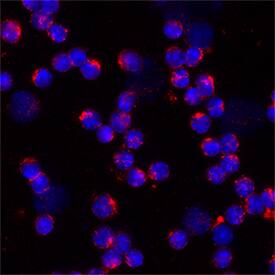Mouse CD200R1 Biotinylated Antibody
R&D Systems, part of Bio-Techne | Catalog # BAF2554


Key Product Details
Species Reactivity
Applications
Label
Antibody Source
Product Specifications
Specificity
Clonality
Host
Isotype
Scientific Data Images for Mouse CD200R1 Biotinylated Antibody
CD200R1 in Mouse Splenocytes.
CD200R1 was detected in immersion fixed mouse splenocytes using Goat Anti-Mouse CD200R1 Biotinylated Antigen Affinity-purified Polyclonal Antibody (Catalog # BAF2554) at 15 µg/mL for 3 hours at room temperature. Cells were stained using the NorthernLights™ 557-conjugated Streptavidin (red; NL999) and counterstained with DAPI (blue). Specific staining was localized to cytoplasm and cell surface. Staining was performed using our protocol for Fluorescent ICC Staining of Non-adherent Cells.Applications for Mouse CD200R1 Biotinylated Antibody
Flow Cytometry
Sample: MC/9-2 mouse masT cell line
Immunocytochemistry
Sample: Immersion fixed mouse splenocytes
Western Blot
Sample: Recombinant Mouse CD200 R1 Fc Chimera (Catalog # 2554-CD)
Formulation, Preparation, and Storage
Purification
Reconstitution
Formulation
Shipping
Stability & Storage
Background: CD200R1
CD200 R1, also known as OX-2 receptor, is a 90 kDa, type I transmembrane protein that belongs to the immunoglobulin superfamily. CD200 R1 is important in the regulation of myeloid cell activity (1‑3). The mouse CD200 R1 cDNA encodes a 326 aa precursor that includes a 25 aa signal sequence, a 213 aa extracellular domain (ECD), a 21 aa transmembrane segment, and a 67 aa cytoplasmic domain. The ECD is composed of one Ig-like V-type domain and one Ig-like C2-type domain (4). Within the ECD, mouse CD200 R1 shares 56% and 70% aa sequence identity with human and rat CD200 R1, respectively. The ECD of mouse CD200 R1 shares 69%, 38%, 79%, and 83% aa sequence identity with the ECD of CD200 R2, 3, 4, and a CD200 R-like molecule, respectively. CD200 R1 is expressed primarily on mast cells, basophils, macrophages, and dendritic cells, (5‑7) while its ligand, CD200, is widely distributed (8). Disruption of this receptor-ligand pair by knockout of the CD200 gene leads to increased macrophage number and activation, plus a predisposition to autoimmune disorders (9). Association of CD200 with CD200 R1 takes place between their respective N-terminal Ig-like domains (10). The CD200 R-like molecules may interact differently with CD200 (11, 12). The cytoplasmic domain of CD200 R1 contains two non-ITIM tyrosine residues which are required for propagating its inhibitory signals (13‑15). CD200 R-like molecules, in contrast, are potentially activating receptors by means of their association with DAP12 (4, 16).
References
- Rosenblum, M.D. et al. (2006) J. Dermatol. Sci. 41:165.
- Gorczynski, R.M. (2005) Curr. Opin. Invest. Drugs 6:483.
- Barclay, A.N. et al. (2002) Trends Immunol. 23:285.
- Wright, G.J. et al. (2003) J. Immunol. 171:3034.
- Shiratori, I. et al. (2005) J. Immunol. 175:4441.
- Cherwinski, H.M. et al. (2005) J. Immunol. 174:1348.
- Fallarino, F. et al. (2004) J. Immunol. 173:3748.
- Wright, G.J. et al. (2001) Immunology 102:173.
- Hoek, R.M. et al. (2000) Science 290:1768.
- Hatherley, D. and A.N. Barclay (2004) Eur. J. Immunol. 34:1688.
- Hatherley, D. et al. (2005) J. Immunol. 175:2469.
- Gorczynski, R. et al. (2004) J. Immunol. 172:7744.
- Zhang, S. and J.H. Phillips (2006) J. Leukoc. Biol. 79:363.
- Zhang, S. et al. (2004) J. Immunol. 173:6786.
- Jenmalm, M.C. et al. (2006) J. Immunol. 176:191.
- Voehringer, D. et al. (2004) J. Biol. Chem. 279:54117.
Long Name
Alternate Names
Gene Symbol
UniProt
Additional CD200R1 Products
Product Documents for Mouse CD200R1 Biotinylated Antibody
Product Specific Notices for Mouse CD200R1 Biotinylated Antibody
For research use only